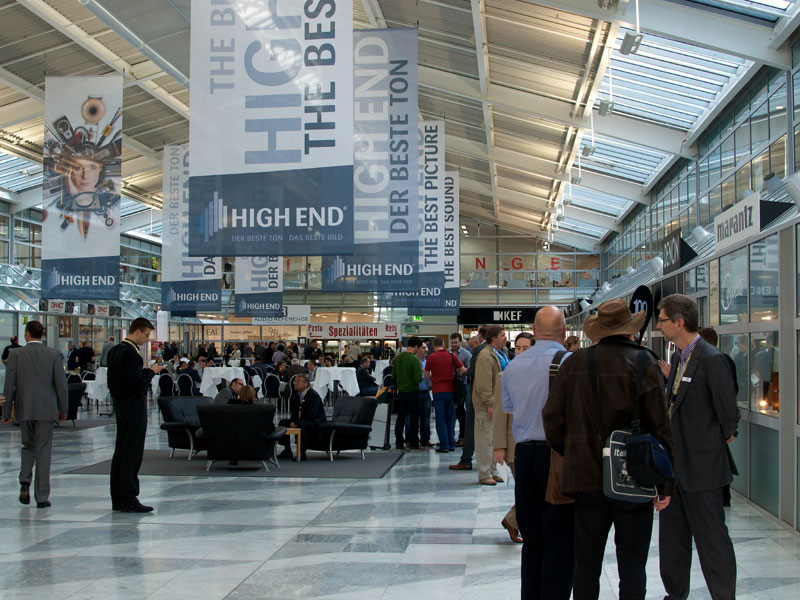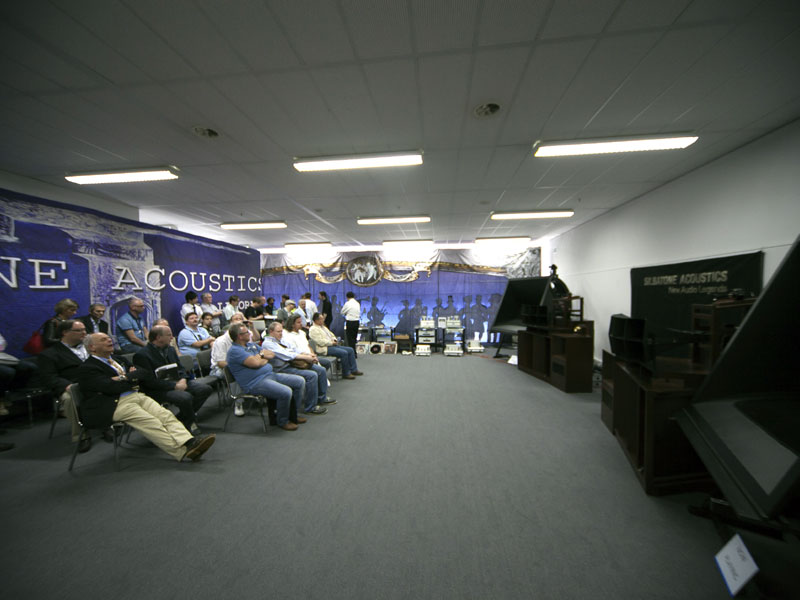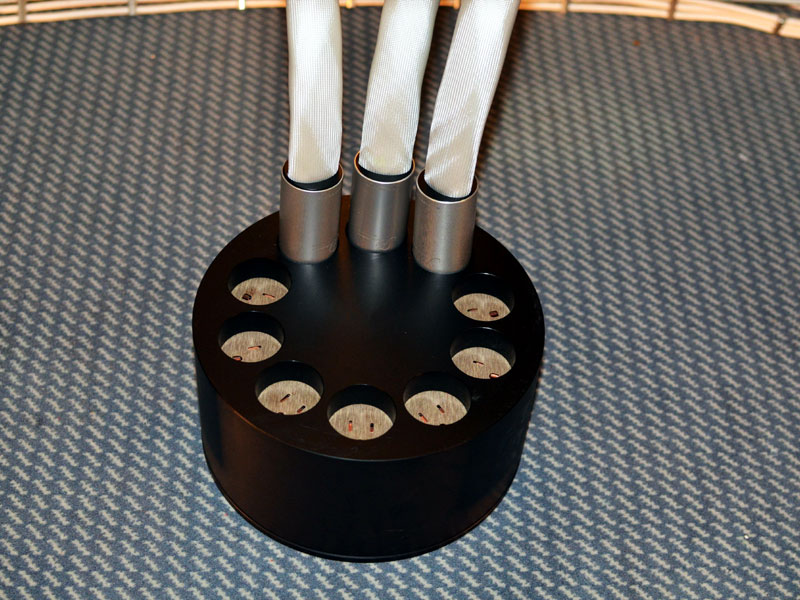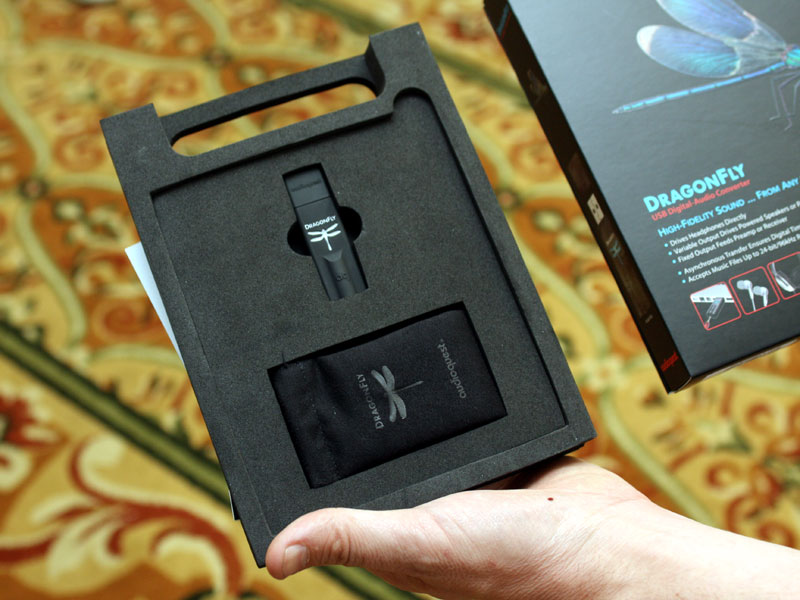High End 2012 • A Feast For the Eyes
The Munich High End show (and the Frankfurt show that predated it) have always been distinctly different -- and distinctly German. Just as any national cuisine is marked by its choice of ingredients and the indignities it imposes on them, hi-fi components often betray their country of origin to the practiced eye. What might seem like subtle markers in isolation become screamingly obvious once you gather an entire nation’s output in a single place. Even mixing in the rest of Europe and the odd American or Far East interloper, it’s hard to miss the dominant trends.
But it’s more than just the equipment on show that sets the Munich show apart. The venue itself has a significant influence. Unlike most hotel-based events, the Munich show is held at the massive MOC exhibition center, a purpose-built facility consisting of multiple halls, each supporting an upper atrium level, an open space offering coffee and other refreshments and surrounded by a further two levels of exhibition rooms, most of them pretty large. With onsite catering, connection to Munich’s U-bahn underground system and an infrastructure designed to handle large, unwieldy exhibits (rather than tourists with checked baggage), you can see why manufacturers might be rubbing their hands in glee. There are few if any venues that can match the MOC when it comes to displaying products; unfortunately, listening to them is quite another matter. Like many modern structures, especially the kind enclosing cavernous interiors, the MOC is essentially a space-frame edifice, all cantilevered metalwork and cladding. That means a lot of metal and even more glass. The carpeting is thin and the walls smooth and highly reflective. There’s virtually no absorption, thin-skin walling separating one room from the next, and you can’t even assume you’ll get curtains. Add to that the sheer size of the spaces and the almost knee-jerk reaction that compels hi-fi companies to install the biggest speakers they can lay their hands on and you can sense the first dull throbs of a gigantic sonic headache. Examples were legion, but perhaps the most apparent was the fallout from the massive Nola Grand Reference VI speakers ($278,000 per system), featuring a pair of 8’-high woofer towers. Bass inside the room was impressive; elsewhere it was simply excessive. With that weird architectural randomness that no one seems able to explain, an entire cannonade of bass notes would suddenly emerge, not next door but four rooms and one floor down, a gigantic low-frequency burp that simply swamped rock, pop, jazz or classical with equal aplomb. This is not Nola’s fault (although a little restraint might have reduced the impact on other exhibitors). In fact, so random is the structural response to low-frequency inputs that it’s possible to remain completely oblivious to the havoc you might be causing, simply because it’s so remote. By the time the victim comes looking for the perpetrator, the Rimsky-Korsakov has been replaced by Mozart or some winsome singer-songwriter pedaling her wares.
With this in mind, many experienced exhibitors opt for static display, often coupled with a system to provide background music. In many cases it’s a wise choice; with the rooms offering the opportunity to show products to real advantage -- or do untold damage to a company’s sonic reputation -- safety is often the best policy. Visit the Munich show and you will undoubtedly see many interesting and fascinating products, but it also underlines just how ludicrous it is to draw any lasting conclusions based on what you hear at shows. And just when you thought things couldn’t get any worse, the nature of the products themselves takes a hand. For years now, the German hi-fi scene has been dominated by massive turntables, long on weight and even longer in the tonearm, and ambitious speaker systems sprouting horns or open baffles with equal abandon. First impressions might be that if something’s worth doing then it’s worth doing it large, but that misses the influence of that other great German virtue, engineering excellence. I’ve lost count of the number of UK- or US-based manufacturers who have complained about finicky German distributors or dealers and their obsession with quality control and finishing issues. Take one look at their domestic product and you soon realize that all they’re expecting is everybody else to rise to the same standards that they take for granted at home. I apologize for the crude national stereotyping (something that seemingly forms the basis of all comedic culture within Europe), but walk the corridors at the Munich show and you’ll see one massive, immaculately engineered and manufactured speaker system after another. Spherical horns are plentiful enough to seem almost normal, with omnis and open baffles all jostling for attention. After all, this is the home of Acapella, MBL, Avantgarde and German Physiks -- and that’s just the more familiar tip of the iceberg.
With all those large (and seriously expensive) systems on show, level was the order of the day. With so many horn systems on show, the potential for really offensive sound was always lurking, and this year it seemed to come home with a vengeance. So much so that Dennis Davis and I felt obliged to create a new category of award in recognition of these (almost physically) impressive efforts. The DFC -- nothing to do with flying, more to do with flight -- stands for Duck For Cover, and this year the award goes to Silbatone, who filled one long wall of a large room with a massive GIP full-range horn system. Multiple cells, cabinets and snail-type enclosures, all driven by field-coil drivers, created a wall of sound that was quite literally terrifying. You no longer need the first twenty minutes of Saving Private Ryan to give you that feeling of intense physical assault; high-frequency notes arrived with the sort of aggressive intent that brings a new immediacy to the term "penetrating trauma." We fled -- and it wasn’t the only time at this show. Less damaging to listeners but no less damaging to the music were levels (and types) of coloration I’ve rarely experienced. Sitting in one room and listening to a huge pair of open baffles, I turned to Dennis and commented that the bass sounded more like a cello and that the pianist was unrecognizable as Oscar Peterson. He looked at me in amazement and asked, "This is Oscar Peterson?" Not only was it Oscar, it was We Get Requests, surely one of the most-played of all audiophile demo discs, yet rendered unrecognizable by the system doing the playing. By now you might be thinking that the Munich show should be given up as a bad job, but that definitely isn’t the case. In amongst the sonic and musical carnage, some hardy souls had created their own little oases of calm. Honorable mention must go to Voxativ, who bucked the horn trend by showing exactly what a good horn system can do -- and why for many listeners it’s a case of once bitten, forever smitten. Using a French Lecteur CD player and a ReVox B-99 to feed their own line stage, 845 monoblocks and Ampeggio Due loudspeakers, all laced together with their own cables, the sound was fast, tactile and coherent, with low levels of coloration and real bass from what is a surprisingly compact enclosure. Voxativ were also making great music at the London show back in September, suggesting that there’s something rather special going on here. Careful use of racks and other ancillaries (Track Audio platforms were under the amps) was to become something of a theme amongst the more successful systems.
One of the first really big systems I heard on day one was in the Tidal/Argento room. Whilst the quality was apparent, it wasn’t really hanging together, but by the final day that had all changed. In fact, this was the best-sounding system I heard using a large conventional speaker system. Looking at the lineup, you’d be forgiven for concluding that it darn well should be, but you’ve still got to make it work. From the top, the system consisted of a Hartvig TT Signature turntable, the Tidal Preos three-box line stage, phono stage and DAC (€23,400) and a pair of Tidal Impulse LPX dual-mono amplifiers (€24,200 each). The amps include a user-selectable high-pass filter, making them particularly suitable for biamping large speakers, which is how they were deployed here, driving Tidal's new Agoria loudspeakers (€68,000 per pair). Cabling was all Argento’s flagship Flow Master Reference, including the company’s new, elegant and extremely compact, circular power-distribution block (below).
Once it hit its stride, this system sounded open, delicate and incredibly transparent. The booming, disjointed bass that marred so many rooms was notably absent -- possibly as a result of the extra control achieved through biamping the speakers -- and all the more remarkable given the paired 11" woofers and three ABRs in each cabinet. Talking of cabinets, the Agoria uses a new material -- Tiralit -- for its enclosure, and the absence of cabinet sound coupled to an extraordinarily low noise floor suggests that Tidal are on to something here. The strength of analog sources in the European and especially the German markets saw advances on the digital-audio front taking something of a back seat. In part this reflects the fact that the computer-audio revolution is being driven by the Stateside consumer, and with Munich coming so hard on the heals of CES, there was little new to note, other than the ubiquity of computer (generally Mac-based) front-ends. Everybody had one, but not many people were injecting a lot of effort into real advances in hardware. However, it also reflects the fact that the pendulum seems to have swung full traverse back towards the DAC, and as it reaches the limit of its arc, the frantic rush to get USB-equipped units to market has subsided. Now seems to be the time to take stock, take a breath and see what happens next. My money is on the next big breakthrough/growth area being in the field of software, but time will tell.
Meanwhile, the most interesting development was AudioQuest’s single-handed assault on all fronts of the personal digital space. The Dragonfly USB thumb-drive DAC paved the way, a $249 device that offers a blend of convenience and accessibility that allows it to score just where the traditional hi-fi buyer expects it least. Factor in a major offensive on data cables and iPhone/iPad connectivity and suddenly you see hi-fi sensibilities and performance benefits intruding into every aspect of the digital domesticity we take so much for granted. Connecting your computer to your hi-fi system? There’s a wire for that. Connecting your iPhone to your USB DAC? There’s a wire for that. Connecting your Blu-ray player to your TV screen? There’s a wire for that too. You get the picture, I’m sure. But the most impressive thing was just how convincingly AudioQuest were able to show the performance dividend that resulted. Forget developing new product for the new generation; first try redeploying the knowledge, product and technology we already have -- at prices potential buyers can actually afford. If you really needed proof of just how great the sonic challenges facing the MOC exhibitors were you needed to go no further than the Marriott, where the off-site HiFi Deluxe parallel show was taking place. With a mere 11 rooms to choose from, it more than made up with quality what it lacked in terms of quantity. Looking at my list of great-sounding rooms, four of the top-five were located at the Marriott, which is a pretty frightening or impressive statistic -- depending on your point of view. That’s nearly 300 rooms plays 11 -- and the 11 won convincingly! Who were the pirates thumbing their noses?
Who had the one stellar system at the MOC? All will be revealed in part two, "A Treat
For The Ears." |






